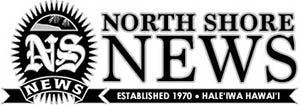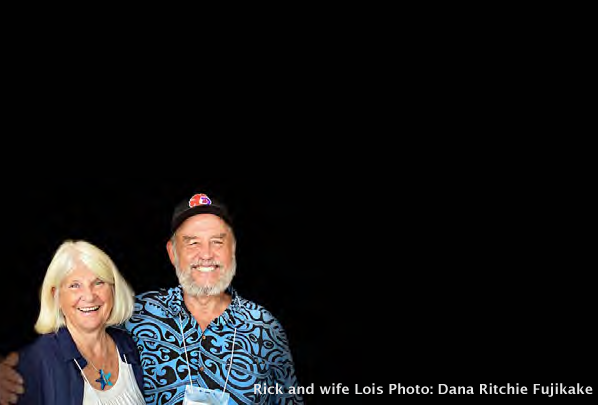by Boyd Ready
Our dear friend and Historic Committee Member of Haleiwa Main Street for over 15 years, Captain Rick Rogers, was suddenly killed in an aircraft crash at Dillingham Airfield in Kawaihapai on February 22nd. No one knows all that Rick did and accomplished, but let us give you a glimpse of a life well lived, rooted in Waialua and our North Shore.
Rick was born in Missouri and finished high school near Charleston, South Carolina. He and his wife Lois arrived in Hawaii and lived a life, at first, of itinerant explorers, using a Volkswagen van, camping, and exploring the Big Island. He wrote his first book “Shipwrecks of Hawai`i” in the late `90s and has worked on a number of academic maritime archaeological projects. One was the only permitted underwater excavation of a shipwreck in Hawaiian waters; that of “Cleopatra’s Barge” otherwise known as “Ha`aheo o Hawai`i, an 1824 shipwreck in Hanalei Bay which brought up the only collection of artifacts belonging to Liholiho, Kamehameha II. He always sought archival information, and walked, dived, and explored the sites of his interests.
He and Lois then settled permanently in Waialua district, raising three daughters. They cleaned out and acted as caretakers of an upland WWII historic site, the hidden, underground shore batteries in the Haleiwa uplands near Drum Road. To visit him meant going through locked gates and a delightful day in the country. Naturally, he also researched and wrote on the coastal defenses and railroad guns of the North Shore in WWII.
In the tradition of our other famed Waialua historians, Samuel Kamakau and Nathaniel Emerson, Captain Rick Rogers sought knowledge independently of schools of history or anthropology and he shared his knowledge generously. He was a Captain of oceangoing vessels, and a pilot, serving with Hawaiian Airlines for 23 years. He wrote on aeronautics and aviation history, and explored and researched all five historic North Shore airfields. He assisted Hawaiian Airlines in finding, making airworthy, flying, then completely restoring, Hawaiian Air’s original 1930’s Italian Bellanca airplane. He served as Hawaiian Airlines historian and archivist, including preparing a lifesize ‘time capsule’ showing seats, uniforms, and equipment for future generations to see. And he volunteered at the Pacific Air Museum on Ford Island, restoring aircraft for public appreciation.
As a nautical archaeologist he was expert in the Spanish galleons and Dutch explorers many passages through the Hawaiian Islands well before Captain Cook, including personal direct archival research in Spain, England and Holland for captain’s logs. His thorough knowledge of Hawaiian legends as recorded, matched with detailed naval records, meant that he gave new accuracy to timelines of Hawaiian genealogy and successive chiefdoms by matching legend to recorded foreign visitors, including marooned sailors.
Captain Rick was a skillful illustrator and artist who did not hesitate to attempt graphic depictions of ancient subjects, ships, and airplanes (one of his watercolors is in the Smithsonian). He wrote at least 75 chapters of “Waialua: The Saga of the North Shore” and at least 40 other articles for the North Shore News using the pen name Kalewa, which means: to float or move with the wind, as clouds. He recently gave masterful, illustrated lectures at Waialua Library on Hawaii’s geology, natural history, ancient Hawaiian, and modern history.
In Haleiwa’s current history he holds pride of place as ‘Captain Haleiwa.’ In the early ‘80’s he had been renting the 900-seat stone-masonry Haleiwa Theater to show movies when demolition was suddenly and illegally started on a Saturday. He stood on the wreckage, in pink cape, tights and goggles every day for six weeks to protest the destruction of the historic building. He didn’t save the theatre, but the City’s ‘Historic Design District’ ordinance was born from his flamboyant protest that publicized the desecration. The design district now protects the rest of Haleiwa’s architectural heritage, thanks to Captain Rick.
Captain Rick’s latest enthusiasm was an old Volkswagen-engine motor-glider he rebuilt and made airworthy. It could not only soar at Mokuleia, it could motor over to the East face of the Koolau’s and soar along the ridgelines above Kaneohe and Kailua.
Rick knew that Dillingham airfield’s civil aviation activities (Scouts learning to fly, national airlines sending pilots to qualify in gliders, pilot training, touch-and-go practice for private pilots from all over the state, and a low-cost place for private hangers) were unique, and critical for Hawai’i. Ten to twenty thousand people a day fly in and out of our State, every last person relying on the skill and experience and integrity of a pilot who knows, really knows, how to fly. Just before Captain Rick died, he wrote an incisive and persuasive letter to the Hawaii DOT challenging them to keep it open.
We honor Captain Rick Rogers as a friend, a father, a self-taught and hands-on Waialua historian, a generous and lively man, and a hero of aviation. He was a true Kama’aina.



